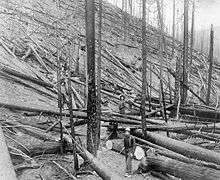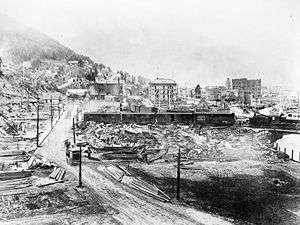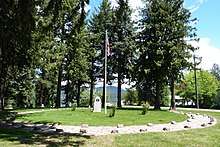Great Fire of 1910
| Great Fire of 1910 | |
|---|---|
 A pine forest on the Little North Fork of the St. Joe River, Idaho, after the fire | |
| Location |
Idaho, Montana, and Washington, United States British Columbia, Canada |
| Statistics | |
| Cost | Unknown |
| Date(s) | August 20–21, 1910 |
| Burned area | 3,000,000 acres (4,700 sq mi; 12,100 km2) |
| Cause | Not officially determined |
| Land use | Logging, mining, railroads |
| Fatalities | 87 |
| Non-fatal injuries | Unknown |
The Great Fire of 1910 (also commonly referred to as the Big Blowup, the Big Burn, or the Devil's Broom fire) was a wildfire in the western United States that burned three million acres (4,700 sq mi; 12,100 km2) in North Idaho and Western Montana, with extensions into Eastern Washington and Southeast British Columbia, in the summer of 1910.[1] The area burned included large parts of the Bitterroot, Cabinet, Clearwater, Coeur d'Alene, Flathead, Kaniksu, Kootenai, Lewis and Clark, Lolo, and St. Joe National Forests.
The fire burned over two days, August 20–21, after strong winds caused numerous smaller fires to combine into a firestorm of unprecedented size. It killed 87 people,[2] mostly firefighters,[3][4] and destroyed numerous manmade structures, including several entire towns. It is believed to be the largest, although not the deadliest, forest fire in U.S. history.[5] The extensive burned area was approximately the size of the state of Connecticut.
In the aftermath of the fire, the U.S. Forest Service received considerable recognition for its firefighting efforts. The outcome was to highlight firefighters as public heroes while raising public awareness of national nature conservation. The fire is often considered a significant impetus in the development of early wildfire prevention and suppression strategies.
Origin
A great number of problems contributed to the destruction caused by the Great Fire of 1910. The fire season started early that year because the spring and summer of 1910 were extremely dry[6] and the summer sufficiently hot to have been described as "like no others".[1] The drought resulted in forests that were teeming with dry fuel, which had previously grown up on abundant autumn and winter moisture.[7] Hundreds of fires were ignited by hot cinders flung from locomotives, sparks, lightning, and backfiring crews. By mid-August, there were 1,000 to 3,000 fires burning in Idaho, Montana, Washington, and British Columbia.[5]
The Big Blowup
On August 20, a cold front blew in and brought hurricane-force winds to the interior Northwest, whipping the hundreds of small fires into one or two much larger blazing infernos.[3] Such a conflagration was impossible to fight; there were too few men and supplies. The United States Forest Service (then called the National Forest Service) was only five years old at the time and unprepared for the possibilities of the dry summer or a fire of this magnitude. Later, at the behest of President William Howard Taft, the U.S. Army's 25th Infantry Regiment (known as the Buffalo Soldiers), was brought in to help fight the blaze.[3][8]
Smoke from the fire was said to have been seen as far east as Watertown, New York, and as far south as Denver, Colorado. It was reported that at night, five hundred miles (800 km) out into the Pacific Ocean, ships could not navigate by the stars because the sky was cloudy with smoke.[5]
The extreme scorching heat of the sudden blowup can be attributed to the expansive Western white pine forests that covered much of northern Idaho at the time. Hydrocarbons in the trees' resinous sap boiled out and created a cloud of highly flammable gas that blanketed hundreds of square miles, which then spontaneously detonated dozens of times, each time sending tongues of flame thousands of feet into the sky and creating a rolling wave of fire that destroyed anything and everything in its path.[9]
Firefighters
At least 78 firefighters were killed while trying to control the fire. The entire 28-man "Lost Crew" was overcome by flames and perished on Setzer Creek outside of Avery, Idaho.[10]
Perhaps the most famous story of survival is that of Ed Pulaski, a U.S. Forest Service ranger who led a large crew to safety in an abandoned prospect mine outside of Wallace, Idaho, just as they were about to be overtaken by the fire. It is said that Pulaski fought off the flames at the mouth of the shaft until he passed out like the others. Around midnight, a man announced that he, at least, was getting out of there. Knowing that they would have no chance of survival if they ran, Pulaski drew his pistol, threatening to shoot the first person who tried to leave. In the end, all but five of the forty or so men survived.[11][12] Pulaski has since been widely celebrated as a hero for his efforts; the mine tunnel in which he and his crew sheltered from the fire is listed on the National Register of Historic Places.
Aftermath


The fire was finally extinguished when another cold front swept in, bringing steady rain.[3] Several towns were completely destroyed by the fire:[13][14][15][16][17][18]
In Idaho, one-third of the town of Wallace was burned to the ground,[14] with an estimated $1 million in damage (equivalent to $26,300,000 in 2017).[15] Passenger trains evacuated thousands of Wallace residents to Spokane and Missoula.[13][14] Another train with 1,000 people from Avery, Idaho took refuge in a tunnel after racing across a burning trestle.[15][19] Other towns with severe damage included Burke, Kellogg, Murray, and Osburn, all in Idaho.[17] The towns of Avery, Idaho and Saltese, Montana, as well as a major part of Wallace, were saved by backfires.
Legacy
The Great Fire of 1910 cemented and shaped the U.S. Forest Service,[16] which at the time was a newly established department on the verge of cancellation. Before the epic conflagration, there were many debates about the best way to handle forest fires—whether to let them burn because they were a part of nature and were expensive to fight, or to fight them in order to protect the forests.[20]
One of the people who fought the fire, Ferdinand A. Silcox, went on to become the fifth chief of the fire service. Influenced by the devastation of the Big Blowup, Silcox promoted the "10 a.m." policy, with the goal of suppressing all fires by 10 a.m. of the day following their report.[21] It was decided that the Forest Service was to prevent and battle every wildfire.[20] More recently, this absolutist attitude to wildfires has been criticized for altering the natural disturbance mechanisms that drive forest ecosystem structure[21], which paradoxically increases the destructive potential of forest fires.
See also
- Great Fire of Spokane City 1889
- Baudette Fire of 1910
- Yacolt Burn
- Avery Depot, a train depot in Avery, Idaho used as an evacuation site
- Edward Pulaski Tunnel and Placer Creek Escape Route, an abandoned prospect mine used by Ed Pulaski to save himself and his crew
- Pulaski, a firefighting tool later designed by and named for Pulaski
References
- 1 2 "Teddy Roosevelt And The Fire That Saved The Forests". NPR. October 29, 2009. Retrieved 2014-05-26.
- ↑ Egan, Timothy. - "Ideas & Trends: Why Foresters Prefer to Fight Fire With Fire". - The New York Times. - August 20, 2000.
- 1 2 3 4 "1910 Fire Season". thinkquest.org. Inferno. Archived from the original on 23 October 2013. Retrieved 1 July 2013. (78 firefighters, 8 civilians)
- ↑ "Deadliest incidents resulting in the deaths of 8 or more firefighters". nfpa.org. National Fire Protection Association. February 2012. Retrieved 1 July 2013. (86 firefighters)
- 1 2 3 Jim Petersen. "The West is Burning Up!". Evergreen Magazine. Idaho Forest Products Commission (Winter Edition 1994–1995). Archived from the original on 2000-10-31. Retrieved 2014-04-26.
- ↑ Idaho Spring/Summer Precipitation; National Oceanic and Atmospheric Administration
- ↑ Idaho Autumn/Winter Precipitation; National Oceanic and Atmospheric Administration
- ↑ Lewis, Edson E. (September 7, 1910), Report of the Commanding Officer of G Company, 25th Infantry Regiment in Fletcher, Marvin (Summer 1972). "Army Fire Fighters" (PDF). Idaho Yesterdays: 12–15. Retrieved July 16, 2014.
- ↑ Peattie, Donald (1950). A Natural History of Western Trees. Boston: Houghton Mifflin. pp. 45–47. ISBN 978-0395581759.
- ↑ Pyne, Stephen J. (2008). Year of the Fires: The Story of the Great Fires of 1910. Missoula, Montana: Mountain Press Publishing Company. pp. 155–157, 175–176. ISBN 978-0-87842-544-0.
- ↑ The Source https://foresthistory.org/wp-content/uploads/2016/12/The-Source-Stephen-Pyne-Lecture.pdf
- ↑ The Big Burn: Idaho and Montana, August 1910 part two "Archived copy". Archived from the original on 2009-04-28. Retrieved 2009-10-09.
- 1 2 Kavenaugh, Laurie. - "On the Scene: Senior Artist Shares Hometown Tragedy". - Chico Enterprise-Record. - August 10, 2000.
- 1 2 3 Geranios, Nicholas K. - "Current Fires Share Similarities with Fires of 1910". - Associated Press. - (c/o Lewiston Morning Tribune. - August 16, 2000.
- 1 2 3 Kramer, Becky. - "A Region's Baptism of Fire". - The Spokesman-Review. - August 21, 2000.
- 1 2 Kramer, Becky (August 22, 2010). "Examining the legacy of the 1910 fires". Spokesman-Review. (Spokane, Washington). Retrieved June 21, 2017.
- 1 2 Landers, Rich. - "Wild Lands in Waiting". - The Spokesman-Review. - September 26, 2004.
—Landers, Rich. - "1910 Forest Fires Sparked Pulaski's Fame". - The Spokesman-Review. - July 2, 2006. - ↑ Kershner, Jim (August 20, 2010). "Great fire wiped out wild towns of Taft, Grand Forks". Spokesman-Review. (Spokane, Washington). Retrieved June 21, 2017.
- ↑ Gidlund, Carl (March 21, 2010). "Rail route tunnels saved lives in big fire". Spokesman-Review. (Spokane, Washington). Retrieved June 21, 2017.
- 1 2 The Big Burn: Idaho and Montana, August 1910 part three http://www.popularmechanics.com/science/earth/4219853.html?page=3
- 1 2 Roberts, Jacob (2015). "The Best of Intentions". Distillations. Chemical Heritage Foundation. 1 (2): 38–39. Retrieved 23 March 2018.
Further reading
- Cohen, Steve, and Donald C. Miller, (1978). - The Big Burn: The Northwest's Forest Fire of 1910. - Missoula, Montana: Pictorial Histories Publishing Company. - 4493723.
- Egan, Timothy, (2009). - The Big Burn: Teddy Roosevelt and the Fire That Saved America - Houghton Mifflin Harcourt - ISBN 0-618-96841-5.
- "When the Mountains Roared: Stories of the 1910 Fire". - Forest History Society.[1]
- Spencer, Betty Goodwin, (1956). - The Big Blowup. - Caldwell, Idaho: Caxton Printers. - 2994642.
External links
- The Big Burn, an episode of PBS American Experience, February 2015
- The 1910 Fires, a history of the Great Fire of 1910 from the Forest History Society website
- "Taming the Dragon" – Missoulian
- "1910 Fire In Mineral County" – Mineral County Historical Society, c/o Mineral County Information and Commerce
- "1910 Fire Commemoration Information Site" – Region One U.S. Forest Service Online Exhibit, with lots of information, maps, photos, a bibliography, etc.
Coordinates: 47°18′N 116°00′W / 47.3°N 116°W
- ↑ Lewis, Edson E. (September 7, 1910), Report of the Commanding Officer of G Company, 25th Infantry Regiment in Fletcher, Marvin (Summer 1972). "Army Fire Fighters" (PDF). Idaho Yesterdays. Retrieved July 16, 2014.